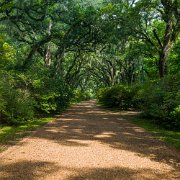
1 Afton Villa Gardens is a historic estate located in St. Francisville, Louisiana. The estate was first established in the 1820s by David Barrow, a wealthy planter, and was named after his family home in Scotland. The estate features a grand antebellum mansion surrounded by 25 acres of formal gardens and parkland. The gardens were designed in the 19th century by renowned landscape architect, Martha Hill, and are considered one of the most beautiful and well-preserved examples of formal gardens in the South. Visitors to Afton Villa Gardens can explore the grounds, which include a serpentine canal, formal parterre gardens, and a moss-draped oak alley. The estate also features a small museum with exhibits on the history of the property and the Barrow family.
Despite suffering significant damage during the Civil War and a devastating fire in 1963, Afton Villa Gardens has been lovingly restored and is now open to the public for tours and events. The gardens have been carefully maintained over the years and are home to a wide variety of trees, shrubs, and flowers, including magnolias, camellias, and azaleas. A visit to Afton Villa Gardens is a step back in time to the antebellum South and a chance to experience the beauty and grandeur of one of the region's most beloved historic estates.
Despite suffering significant damage during the Civil War and a devastating fire in 1963, Afton Villa Gardens has been lovingly restored and is now open to the public for tours and events. The gardens have been carefully maintained over the years and are home to a wide variety of trees, shrubs, and flowers, including magnolias, camellias, and azaleas. A visit to Afton Villa Gardens is a step back in time to the antebellum South and a chance to experience the beauty and grandeur of one of the region's most beloved historic estates.
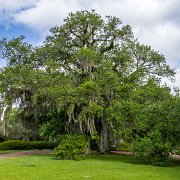
2 Afton Villa Gardens is a historic estate located in St. Francisville, Louisiana. The estate was first established in the 1820s by David Barrow, a wealthy planter, and was named after his family home in Scotland. The estate features a grand antebellum mansion surrounded by 25 acres of formal gardens and parkland. The gardens were designed in the 19th century by renowned landscape architect, Martha Hill, and are considered one of the most beautiful and well-preserved examples of formal gardens in the South. Visitors to Afton Villa Gardens can explore the grounds, which include a serpentine canal, formal parterre gardens, and a moss-draped oak alley. The estate also features a small museum with exhibits on the history of the property and the Barrow family.
Despite suffering significant damage during the Civil War and a devastating fire in 1963, Afton Villa Gardens has been lovingly restored and is now open to the public for tours and events. The gardens have been carefully maintained over the years and are home to a wide variety of trees, shrubs, and flowers, including magnolias, camellias, and azaleas. A visit to Afton Villa Gardens is a step back in time to the antebellum South and a chance to experience the beauty and grandeur of one of the region's most beloved historic estates.
Despite suffering significant damage during the Civil War and a devastating fire in 1963, Afton Villa Gardens has been lovingly restored and is now open to the public for tours and events. The gardens have been carefully maintained over the years and are home to a wide variety of trees, shrubs, and flowers, including magnolias, camellias, and azaleas. A visit to Afton Villa Gardens is a step back in time to the antebellum South and a chance to experience the beauty and grandeur of one of the region's most beloved historic estates.
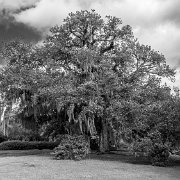
3 Afton Villa Gardens is a historic estate located in St. Francisville, Louisiana. The estate was first established in the 1820s by David Barrow, a wealthy planter, and was named after his family home in Scotland. The estate features a grand antebellum mansion surrounded by 25 acres of formal gardens and parkland. The gardens were designed in the 19th century by renowned landscape architect, Martha Hill, and are considered one of the most beautiful and well-preserved examples of formal gardens in the South. Visitors to Afton Villa Gardens can explore the grounds, which include a serpentine canal, formal parterre gardens, and a moss-draped oak alley. The estate also features a small museum with exhibits on the history of the property and the Barrow family.
Despite suffering significant damage during the Civil War and a devastating fire in 1963, Afton Villa Gardens has been lovingly restored and is now open to the public for tours and events. The gardens have been carefully maintained over the years and are home to a wide variety of trees, shrubs, and flowers, including magnolias, camellias, and azaleas. A visit to Afton Villa Gardens is a step back in time to the antebellum South and a chance to experience the beauty and grandeur of one of the region's most beloved historic estates.
Despite suffering significant damage during the Civil War and a devastating fire in 1963, Afton Villa Gardens has been lovingly restored and is now open to the public for tours and events. The gardens have been carefully maintained over the years and are home to a wide variety of trees, shrubs, and flowers, including magnolias, camellias, and azaleas. A visit to Afton Villa Gardens is a step back in time to the antebellum South and a chance to experience the beauty and grandeur of one of the region's most beloved historic estates.
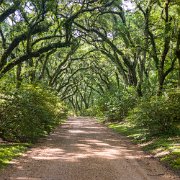
4 Afton Villa Gardens is a historic estate located in St. Francisville, Louisiana. The estate was first established in the 1820s by David Barrow, a wealthy planter, and was named after his family home in Scotland. The estate features a grand antebellum mansion surrounded by 25 acres of formal gardens and parkland. The gardens were designed in the 19th century by renowned landscape architect, Martha Hill, and are considered one of the most beautiful and well-preserved examples of formal gardens in the South. Visitors to Afton Villa Gardens can explore the grounds, which include a serpentine canal, formal parterre gardens, and a moss-draped oak alley. The estate also features a small museum with exhibits on the history of the property and the Barrow family.
Despite suffering significant damage during the Civil War and a devastating fire in 1963, Afton Villa Gardens has been lovingly restored and is now open to the public for tours and events. The gardens have been carefully maintained over the years and are home to a wide variety of trees, shrubs, and flowers, including magnolias, camellias, and azaleas. A visit to Afton Villa Gardens is a step back in time to the antebellum South and a chance to experience the beauty and grandeur of one of the region's most beloved historic estates.
Despite suffering significant damage during the Civil War and a devastating fire in 1963, Afton Villa Gardens has been lovingly restored and is now open to the public for tours and events. The gardens have been carefully maintained over the years and are home to a wide variety of trees, shrubs, and flowers, including magnolias, camellias, and azaleas. A visit to Afton Villa Gardens is a step back in time to the antebellum South and a chance to experience the beauty and grandeur of one of the region's most beloved historic estates.
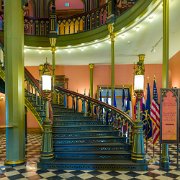
5 The Old State Capitol in Baton Rouge, Louisiana is an iconic example of Gothic Revival architecture. The building was constructed in the mid-19th century and served as the state capitol from 1852 to 1932. The Old State Capitol is notable for its striking appearance, with its towering spires, pointed arches, and ornate decorations. The building is also significant for its role in Louisiana history, serving as the site of many important political events, including the passage of the Louisiana secession ordinance in 1861. Today, the Old State Capitol is a museum that showcases the history of Louisiana politics and government, as well as the unique architectural heritage of the building itself.
One of the most famous features of the Old State Capitol is its stained-glass dome, which rises 75 feet above the rotunda. The dome is made up of more than 600 panels of stained glass and is illuminated by natural light during the day and artificial light at night. The interior of the building also features impressive woodwork and plasterwork, as well as murals that depict scenes from Louisiana history. The Old State Capitol is an important landmark in Baton Rouge and a popular destination for visitors to Louisiana who are interested in history, politics, and architecture.
One of the most famous features of the Old State Capitol is its stained-glass dome, which rises 75 feet above the rotunda. The dome is made up of more than 600 panels of stained glass and is illuminated by natural light during the day and artificial light at night. The interior of the building also features impressive woodwork and plasterwork, as well as murals that depict scenes from Louisiana history. The Old State Capitol is an important landmark in Baton Rouge and a popular destination for visitors to Louisiana who are interested in history, politics, and architecture.
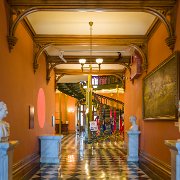
6 The Old State Capitol in Baton Rouge, Louisiana is an iconic example of Gothic Revival architecture. The building was constructed in the mid-19th century and served as the state capitol from 1852 to 1932. The Old State Capitol is notable for its striking appearance, with its towering spires, pointed arches, and ornate decorations. The building is also significant for its role in Louisiana history, serving as the site of many important political events, including the passage of the Louisiana secession ordinance in 1861. Today, the Old State Capitol is a museum that showcases the history of Louisiana politics and government, as well as the unique architectural heritage of the building itself.
One of the most famous features of the Old State Capitol is its stained-glass dome, which rises 75 feet above the rotunda. The dome is made up of more than 600 panels of stained glass and is illuminated by natural light during the day and artificial light at night. The interior of the building also features impressive woodwork and plasterwork, as well as murals that depict scenes from Louisiana history. The Old State Capitol is an important landmark in Baton Rouge and a popular destination for visitors to Louisiana who are interested in history, politics, and architecture.
One of the most famous features of the Old State Capitol is its stained-glass dome, which rises 75 feet above the rotunda. The dome is made up of more than 600 panels of stained glass and is illuminated by natural light during the day and artificial light at night. The interior of the building also features impressive woodwork and plasterwork, as well as murals that depict scenes from Louisiana history. The Old State Capitol is an important landmark in Baton Rouge and a popular destination for visitors to Louisiana who are interested in history, politics, and architecture.
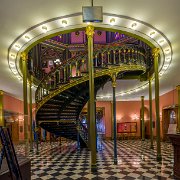
7 The Old State Capitol in Baton Rouge, Louisiana is an iconic example of Gothic Revival architecture. The building was constructed in the mid-19th century and served as the state capitol from 1852 to 1932. The Old State Capitol is notable for its striking appearance, with its towering spires, pointed arches, and ornate decorations. The building is also significant for its role in Louisiana history, serving as the site of many important political events, including the passage of the Louisiana secession ordinance in 1861. Today, the Old State Capitol is a museum that showcases the history of Louisiana politics and government, as well as the unique architectural heritage of the building itself.
One of the most famous features of the Old State Capitol is its stained-glass dome, which rises 75 feet above the rotunda. The dome is made up of more than 600 panels of stained glass and is illuminated by natural light during the day and artificial light at night. The interior of the building also features impressive woodwork and plasterwork, as well as murals that depict scenes from Louisiana history. The Old State Capitol is an important landmark in Baton Rouge and a popular destination for visitors to Louisiana who are interested in history, politics, and architecture.
One of the most famous features of the Old State Capitol is its stained-glass dome, which rises 75 feet above the rotunda. The dome is made up of more than 600 panels of stained glass and is illuminated by natural light during the day and artificial light at night. The interior of the building also features impressive woodwork and plasterwork, as well as murals that depict scenes from Louisiana history. The Old State Capitol is an important landmark in Baton Rouge and a popular destination for visitors to Louisiana who are interested in history, politics, and architecture.
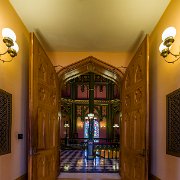
8 The Old State Capitol in Baton Rouge, Louisiana is an iconic example of Gothic Revival architecture. The building was constructed in the mid-19th century and served as the state capitol from 1852 to 1932. The Old State Capitol is notable for its striking appearance, with its towering spires, pointed arches, and ornate decorations. The building is also significant for its role in Louisiana history, serving as the site of many important political events, including the passage of the Louisiana secession ordinance in 1861. Today, the Old State Capitol is a museum that showcases the history of Louisiana politics and government, as well as the unique architectural heritage of the building itself.
One of the most famous features of the Old State Capitol is its stained-glass dome, which rises 75 feet above the rotunda. The dome is made up of more than 600 panels of stained glass and is illuminated by natural light during the day and artificial light at night. The interior of the building also features impressive woodwork and plasterwork, as well as murals that depict scenes from Louisiana history. The Old State Capitol is an important landmark in Baton Rouge and a popular destination for visitors to Louisiana who are interested in history, politics, and architecture.
One of the most famous features of the Old State Capitol is its stained-glass dome, which rises 75 feet above the rotunda. The dome is made up of more than 600 panels of stained glass and is illuminated by natural light during the day and artificial light at night. The interior of the building also features impressive woodwork and plasterwork, as well as murals that depict scenes from Louisiana history. The Old State Capitol is an important landmark in Baton Rouge and a popular destination for visitors to Louisiana who are interested in history, politics, and architecture.
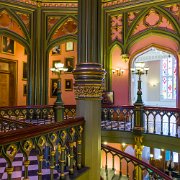
9 The Old State Capitol in Baton Rouge, Louisiana is an iconic example of Gothic Revival architecture. The building was constructed in the mid-19th century and served as the state capitol from 1852 to 1932. The Old State Capitol is notable for its striking appearance, with its towering spires, pointed arches, and ornate decorations. The building is also significant for its role in Louisiana history, serving as the site of many important political events, including the passage of the Louisiana secession ordinance in 1861. Today, the Old State Capitol is a museum that showcases the history of Louisiana politics and government, as well as the unique architectural heritage of the building itself.
One of the most famous features of the Old State Capitol is its stained-glass dome, which rises 75 feet above the rotunda. The dome is made up of more than 600 panels of stained glass and is illuminated by natural light during the day and artificial light at night. The interior of the building also features impressive woodwork and plasterwork, as well as murals that depict scenes from Louisiana history. The Old State Capitol is an important landmark in Baton Rouge and a popular destination for visitors to Louisiana who are interested in history, politics, and architecture.
One of the most famous features of the Old State Capitol is its stained-glass dome, which rises 75 feet above the rotunda. The dome is made up of more than 600 panels of stained glass and is illuminated by natural light during the day and artificial light at night. The interior of the building also features impressive woodwork and plasterwork, as well as murals that depict scenes from Louisiana history. The Old State Capitol is an important landmark in Baton Rouge and a popular destination for visitors to Louisiana who are interested in history, politics, and architecture.
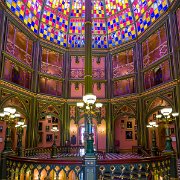
10 The Old State Capitol in Baton Rouge, Louisiana is an iconic example of Gothic Revival architecture. The building was constructed in the mid-19th century and served as the state capitol from 1852 to 1932. The Old State Capitol is notable for its striking appearance, with its towering spires, pointed arches, and ornate decorations. The building is also significant for its role in Louisiana history, serving as the site of many important political events, including the passage of the Louisiana secession ordinance in 1861. Today, the Old State Capitol is a museum that showcases the history of Louisiana politics and government, as well as the unique architectural heritage of the building itself.
One of the most famous features of the Old State Capitol is its stained-glass dome, which rises 75 feet above the rotunda. The dome is made up of more than 600 panels of stained glass and is illuminated by natural light during the day and artificial light at night. The interior of the building also features impressive woodwork and plasterwork, as well as murals that depict scenes from Louisiana history. The Old State Capitol is an important landmark in Baton Rouge and a popular destination for visitors to Louisiana who are interested in history, politics, and architecture.
One of the most famous features of the Old State Capitol is its stained-glass dome, which rises 75 feet above the rotunda. The dome is made up of more than 600 panels of stained glass and is illuminated by natural light during the day and artificial light at night. The interior of the building also features impressive woodwork and plasterwork, as well as murals that depict scenes from Louisiana history. The Old State Capitol is an important landmark in Baton Rouge and a popular destination for visitors to Louisiana who are interested in history, politics, and architecture.
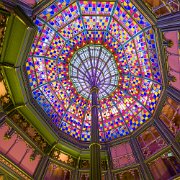
11 The Old State Capitol in Baton Rouge, Louisiana is an iconic example of Gothic Revival architecture. The building was constructed in the mid-19th century and served as the state capitol from 1852 to 1932. The Old State Capitol is notable for its striking appearance, with its towering spires, pointed arches, and ornate decorations. The building is also significant for its role in Louisiana history, serving as the site of many important political events, including the passage of the Louisiana secession ordinance in 1861. Today, the Old State Capitol is a museum that showcases the history of Louisiana politics and government, as well as the unique architectural heritage of the building itself.
One of the most famous features of the Old State Capitol is its stained-glass dome, which rises 75 feet above the rotunda. The dome is made up of more than 600 panels of stained glass and is illuminated by natural light during the day and artificial light at night. The interior of the building also features impressive woodwork and plasterwork, as well as murals that depict scenes from Louisiana history. The Old State Capitol is an important landmark in Baton Rouge and a popular destination for visitors to Louisiana who are interested in history, politics, and architecture.
One of the most famous features of the Old State Capitol is its stained-glass dome, which rises 75 feet above the rotunda. The dome is made up of more than 600 panels of stained glass and is illuminated by natural light during the day and artificial light at night. The interior of the building also features impressive woodwork and plasterwork, as well as murals that depict scenes from Louisiana history. The Old State Capitol is an important landmark in Baton Rouge and a popular destination for visitors to Louisiana who are interested in history, politics, and architecture.
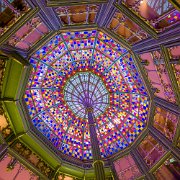
12 The Old State Capitol in Baton Rouge, Louisiana is an iconic example of Gothic Revival architecture. The building was constructed in the mid-19th century and served as the state capitol from 1852 to 1932. The Old State Capitol is notable for its striking appearance, with its towering spires, pointed arches, and ornate decorations. The building is also significant for its role in Louisiana history, serving as the site of many important political events, including the passage of the Louisiana secession ordinance in 1861. Today, the Old State Capitol is a museum that showcases the history of Louisiana politics and government, as well as the unique architectural heritage of the building itself.
One of the most famous features of the Old State Capitol is its stained-glass dome, which rises 75 feet above the rotunda. The dome is made up of more than 600 panels of stained glass and is illuminated by natural light during the day and artificial light at night. The interior of the building also features impressive woodwork and plasterwork, as well as murals that depict scenes from Louisiana history. The Old State Capitol is an important landmark in Baton Rouge and a popular destination for visitors to Louisiana who are interested in history, politics, and architecture.
One of the most famous features of the Old State Capitol is its stained-glass dome, which rises 75 feet above the rotunda. The dome is made up of more than 600 panels of stained glass and is illuminated by natural light during the day and artificial light at night. The interior of the building also features impressive woodwork and plasterwork, as well as murals that depict scenes from Louisiana history. The Old State Capitol is an important landmark in Baton Rouge and a popular destination for visitors to Louisiana who are interested in history, politics, and architecture.

14 Honey Island Swamp in Louisiana is a captivating and mysterious natural wonder. Located in the southeastern part of the state, this expansive swamp covers over 70,000 acres of diverse ecosystems, including marshes, hardwood forests, and cypress-tupelo swamps. The swamp is known for its pristine and untouched beauty, offering visitors a glimpse into the enchanting and untamed wilderness of Louisiana. It is home to a plethora of wildlife, including alligators, black bears, otters, and a wide variety of bird species. The dense cypress trees draped with Spanish moss create an otherworldly atmosphere, evoking a sense of tranquility and awe. Visitors can explore the swamp's meandering waterways by boat or kayak, immersing themselves in the serene surroundings and witnessing the incredible biodiversity that thrives within this remarkable natural habitat.
Beyond its natural allure, Honey Island Swamp also holds a place in local folklore and legends. The swamp is said to be named after a group of bees that escaped from a French explorer's shipwreck, settling in the area and creating beehives on the trees. This tale adds to the swamp's mystique and adds an air of enchantment to the already captivating landscape. Honey Island Swamp serves as a haven for nature enthusiasts, photographers, and those seeking an unforgettable adventure in one of Louisiana's most captivating and evocative natural settings.
Beyond its natural allure, Honey Island Swamp also holds a place in local folklore and legends. The swamp is said to be named after a group of bees that escaped from a French explorer's shipwreck, settling in the area and creating beehives on the trees. This tale adds to the swamp's mystique and adds an air of enchantment to the already captivating landscape. Honey Island Swamp serves as a haven for nature enthusiasts, photographers, and those seeking an unforgettable adventure in one of Louisiana's most captivating and evocative natural settings.

15 Honey Island Swamp in Louisiana is a captivating and mysterious natural wonder. Located in the southeastern part of the state, this expansive swamp covers over 70,000 acres of diverse ecosystems, including marshes, hardwood forests, and cypress-tupelo swamps. The swamp is known for its pristine and untouched beauty, offering visitors a glimpse into the enchanting and untamed wilderness of Louisiana. It is home to a plethora of wildlife, including alligators, black bears, otters, and a wide variety of bird species. The dense cypress trees draped with Spanish moss create an otherworldly atmosphere, evoking a sense of tranquility and awe. Visitors can explore the swamp's meandering waterways by boat or kayak, immersing themselves in the serene surroundings and witnessing the incredible biodiversity that thrives within this remarkable natural habitat.
Beyond its natural allure, Honey Island Swamp also holds a place in local folklore and legends. The swamp is said to be named after a group of bees that escaped from a French explorer's shipwreck, settling in the area and creating beehives on the trees. This tale adds to the swamp's mystique and adds an air of enchantment to the already captivating landscape. Honey Island Swamp serves as a haven for nature enthusiasts, photographers, and those seeking an unforgettable adventure in one of Louisiana's most captivating and evocative natural settings.
Beyond its natural allure, Honey Island Swamp also holds a place in local folklore and legends. The swamp is said to be named after a group of bees that escaped from a French explorer's shipwreck, settling in the area and creating beehives on the trees. This tale adds to the swamp's mystique and adds an air of enchantment to the already captivating landscape. Honey Island Swamp serves as a haven for nature enthusiasts, photographers, and those seeking an unforgettable adventure in one of Louisiana's most captivating and evocative natural settings.

16 Honey Island Swamp in Louisiana is a captivating and mysterious natural wonder. Located in the southeastern part of the state, this expansive swamp covers over 70,000 acres of diverse ecosystems, including marshes, hardwood forests, and cypress-tupelo swamps. The swamp is known for its pristine and untouched beauty, offering visitors a glimpse into the enchanting and untamed wilderness of Louisiana. It is home to a plethora of wildlife, including alligators, black bears, otters, and a wide variety of bird species. The dense cypress trees draped with Spanish moss create an otherworldly atmosphere, evoking a sense of tranquility and awe. Visitors can explore the swamp's meandering waterways by boat or kayak, immersing themselves in the serene surroundings and witnessing the incredible biodiversity that thrives within this remarkable natural habitat.
Beyond its natural allure, Honey Island Swamp also holds a place in local folklore and legends. The swamp is said to be named after a group of bees that escaped from a French explorer's shipwreck, settling in the area and creating beehives on the trees. This tale adds to the swamp's mystique and adds an air of enchantment to the already captivating landscape. Honey Island Swamp serves as a haven for nature enthusiasts, photographers, and those seeking an unforgettable adventure in one of Louisiana's most captivating and evocative natural settings.
Beyond its natural allure, Honey Island Swamp also holds a place in local folklore and legends. The swamp is said to be named after a group of bees that escaped from a French explorer's shipwreck, settling in the area and creating beehives on the trees. This tale adds to the swamp's mystique and adds an air of enchantment to the already captivating landscape. Honey Island Swamp serves as a haven for nature enthusiasts, photographers, and those seeking an unforgettable adventure in one of Louisiana's most captivating and evocative natural settings.

17 Honey Island Swamp in Louisiana is a captivating and mysterious natural wonder. Located in the southeastern part of the state, this expansive swamp covers over 70,000 acres of diverse ecosystems, including marshes, hardwood forests, and cypress-tupelo swamps. The swamp is known for its pristine and untouched beauty, offering visitors a glimpse into the enchanting and untamed wilderness of Louisiana. It is home to a plethora of wildlife, including alligators, black bears, otters, and a wide variety of bird species. The dense cypress trees draped with Spanish moss create an otherworldly atmosphere, evoking a sense of tranquility and awe. Visitors can explore the swamp's meandering waterways by boat or kayak, immersing themselves in the serene surroundings and witnessing the incredible biodiversity that thrives within this remarkable natural habitat.
Beyond its natural allure, Honey Island Swamp also holds a place in local folklore and legends. The swamp is said to be named after a group of bees that escaped from a French explorer's shipwreck, settling in the area and creating beehives on the trees. This tale adds to the swamp's mystique and adds an air of enchantment to the already captivating landscape. Honey Island Swamp serves as a haven for nature enthusiasts, photographers, and those seeking an unforgettable adventure in one of Louisiana's most captivating and evocative natural settings.
Beyond its natural allure, Honey Island Swamp also holds a place in local folklore and legends. The swamp is said to be named after a group of bees that escaped from a French explorer's shipwreck, settling in the area and creating beehives on the trees. This tale adds to the swamp's mystique and adds an air of enchantment to the already captivating landscape. Honey Island Swamp serves as a haven for nature enthusiasts, photographers, and those seeking an unforgettable adventure in one of Louisiana's most captivating and evocative natural settings.

18 Honey Island Swamp in Louisiana is a captivating and mysterious natural wonder. Located in the southeastern part of the state, this expansive swamp covers over 70,000 acres of diverse ecosystems, including marshes, hardwood forests, and cypress-tupelo swamps. The swamp is known for its pristine and untouched beauty, offering visitors a glimpse into the enchanting and untamed wilderness of Louisiana. It is home to a plethora of wildlife, including alligators, black bears, otters, and a wide variety of bird species. The dense cypress trees draped with Spanish moss create an otherworldly atmosphere, evoking a sense of tranquility and awe. Visitors can explore the swamp's meandering waterways by boat or kayak, immersing themselves in the serene surroundings and witnessing the incredible biodiversity that thrives within this remarkable natural habitat.
Beyond its natural allure, Honey Island Swamp also holds a place in local folklore and legends. The swamp is said to be named after a group of bees that escaped from a French explorer's shipwreck, settling in the area and creating beehives on the trees. This tale adds to the swamp's mystique and adds an air of enchantment to the already captivating landscape. Honey Island Swamp serves as a haven for nature enthusiasts, photographers, and those seeking an unforgettable adventure in one of Louisiana's most captivating and evocative natural settings.
Beyond its natural allure, Honey Island Swamp also holds a place in local folklore and legends. The swamp is said to be named after a group of bees that escaped from a French explorer's shipwreck, settling in the area and creating beehives on the trees. This tale adds to the swamp's mystique and adds an air of enchantment to the already captivating landscape. Honey Island Swamp serves as a haven for nature enthusiasts, photographers, and those seeking an unforgettable adventure in one of Louisiana's most captivating and evocative natural settings.

19 Honey Island Swamp in Louisiana is a captivating and mysterious natural wonder. Located in the southeastern part of the state, this expansive swamp covers over 70,000 acres of diverse ecosystems, including marshes, hardwood forests, and cypress-tupelo swamps. The swamp is known for its pristine and untouched beauty, offering visitors a glimpse into the enchanting and untamed wilderness of Louisiana. It is home to a plethora of wildlife, including alligators, black bears, otters, and a wide variety of bird species. The dense cypress trees draped with Spanish moss create an otherworldly atmosphere, evoking a sense of tranquility and awe. Visitors can explore the swamp's meandering waterways by boat or kayak, immersing themselves in the serene surroundings and witnessing the incredible biodiversity that thrives within this remarkable natural habitat.
Beyond its natural allure, Honey Island Swamp also holds a place in local folklore and legends. The swamp is said to be named after a group of bees that escaped from a French explorer's shipwreck, settling in the area and creating beehives on the trees. This tale adds to the swamp's mystique and adds an air of enchantment to the already captivating landscape. Honey Island Swamp serves as a haven for nature enthusiasts, photographers, and those seeking an unforgettable adventure in one of Louisiana's most captivating and evocative natural settings.
Beyond its natural allure, Honey Island Swamp also holds a place in local folklore and legends. The swamp is said to be named after a group of bees that escaped from a French explorer's shipwreck, settling in the area and creating beehives on the trees. This tale adds to the swamp's mystique and adds an air of enchantment to the already captivating landscape. Honey Island Swamp serves as a haven for nature enthusiasts, photographers, and those seeking an unforgettable adventure in one of Louisiana's most captivating and evocative natural settings.

20 Honey Island Swamp in Louisiana is a captivating and mysterious natural wonder. Located in the southeastern part of the state, this expansive swamp covers over 70,000 acres of diverse ecosystems, including marshes, hardwood forests, and cypress-tupelo swamps. The swamp is known for its pristine and untouched beauty, offering visitors a glimpse into the enchanting and untamed wilderness of Louisiana. It is home to a plethora of wildlife, including alligators, black bears, otters, and a wide variety of bird species. The dense cypress trees draped with Spanish moss create an otherworldly atmosphere, evoking a sense of tranquility and awe. Visitors can explore the swamp's meandering waterways by boat or kayak, immersing themselves in the serene surroundings and witnessing the incredible biodiversity that thrives within this remarkable natural habitat.
Beyond its natural allure, Honey Island Swamp also holds a place in local folklore and legends. The swamp is said to be named after a group of bees that escaped from a French explorer's shipwreck, settling in the area and creating beehives on the trees. This tale adds to the swamp's mystique and adds an air of enchantment to the already captivating landscape. Honey Island Swamp serves as a haven for nature enthusiasts, photographers, and those seeking an unforgettable adventure in one of Louisiana's most captivating and evocative natural settings.
Beyond its natural allure, Honey Island Swamp also holds a place in local folklore and legends. The swamp is said to be named after a group of bees that escaped from a French explorer's shipwreck, settling in the area and creating beehives on the trees. This tale adds to the swamp's mystique and adds an air of enchantment to the already captivating landscape. Honey Island Swamp serves as a haven for nature enthusiasts, photographers, and those seeking an unforgettable adventure in one of Louisiana's most captivating and evocative natural settings.
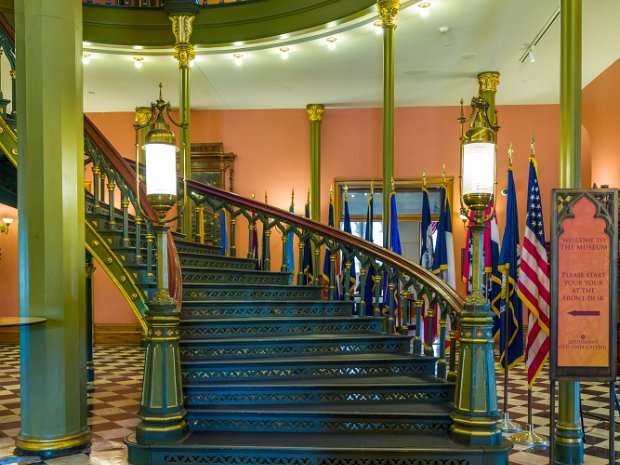

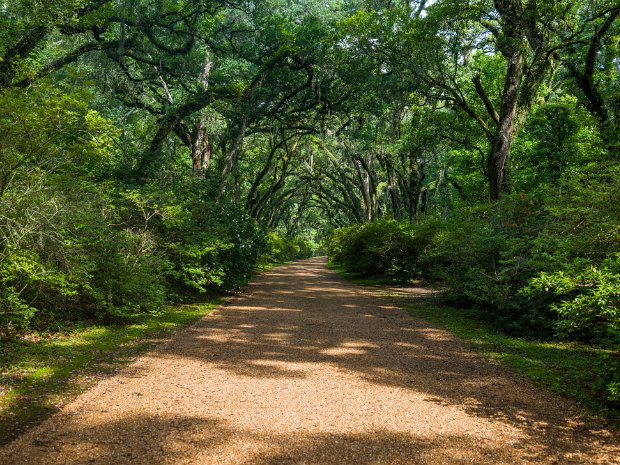
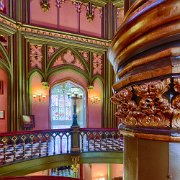
Louisiana